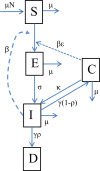A Mathematical Model that Simulates Control Options for African Swine Fever Virus (ASFV)
- PMID: 27391689
- PMCID: PMC4938631
- DOI: 10.1371/journal.pone.0158658
A Mathematical Model that Simulates Control Options for African Swine Fever Virus (ASFV)
Abstract
A stochastic model designed to simulate transmission dynamics of African swine fever virus (ASFV) in a free-ranging pig population under various intervention scenarios is presented. The model was used to assess the relative impact of the timing of the implementation of different control strategies on disease-related mortality. The implementation of biosecurity measures was simulated through incorporation of a decay function on the transmission rate. The model predicts that biosecurity measures implemented within 14 days of the onset of an epidemic can avert up to 74% of pig deaths due to ASF while hypothetical vaccines that confer 70% immunity when deployed prior to day 14 of the epidemic could avert 65% of pig deaths. When the two control measures are combined, the model predicts that 91% of the pigs that would have otherwise succumbed to the disease if no intervention was implemented would be saved. However, if the combined interventions are delayed (defined as implementation from > 60 days) only 30% of ASF-related deaths would be averted. In the absence of vaccines against ASF, we recommend early implementation of enhanced biosecurity measures. Active surveillance and use of pen-side diagnostic assays, preferably linked to rapid dissemination of this data to veterinary authorities through mobile phone technology platforms are essential for rapid detection and confirmation of ASF outbreaks. This prediction, although it may seem intuitive, rationally confirms the importance of early intervention in managing ASF epidemics. The modelling approach is particularly valuable in that it determines an optimal timing for implementation of interventions in controlling ASF outbreaks.
Conflict of interest statement
Figures



References
-
- Dixon L, Costa J V, Escribano JM, Vinuela E, Wilkinson PJ. Family Asfarviridae In: Van Regenmortel M, Fauquel C, Bishop D, editors. Virus taxonomy, 7th Report of the ICTV. San Diego: Academic Press; 2000. p. 159–65.
-
- OIE. African Swine Fever. 2010;1–4. Available: http://www.levendehave.nl/sites/default/files/bestanden/African_swine_fe...
-
- Atuhaire DK, Ochwo S, Afayoa M, Mwiine FN, Kokas I, Arinaitwe E, et al. Epidemiological Overview of African Swine Fever in Uganda (2001–2012). J Vet Med [Internet]. 2013;2013:1–9. Available: http://www.hindawi.com/journals/jvm/2013/949638/ - PMC - PubMed
MeSH terms
Grants and funding
LinkOut - more resources
Full Text Sources
Other Literature Sources

